Thursday, February 25, 2010
The Red River now at lowest level on record
VietNamNet Bridge – Despite earlier tidal rises, on February 22, 7pm, the water in the Red River was only 10cm high, the lowest level on records.
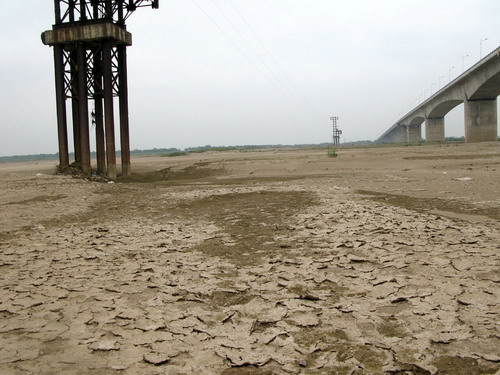
The 3.7km Vinh Tuy Bridge across the Red River has become a viaduct with only one pile under water.
Due to the drying up since November 2009, sand-banks amid the river are rapidly expanding and become green grass fields.
Below the Vinh Tuy Bridge, Hanoi, is a vast sand-bank of thousands of meters. This modern bridge, which was inaugurated over 4 months ago, now has only one pile under water. The sand-bank under the Vinh Tuy bridge has become a sand mining site.
As of February 18, a section of river near the Long Bien Bridge has been dredged. This work will be carried out in 26 days to make a passage of 1.5m depth for boats. However, the water level has continued to fall.
Le Van Luong, director of the Waterway Management JS Company No. 6, the firm that is doing the dredging, complained: “It is useless to dredge the river when the water level falls below 10cm and rises to only 15-20cm”. Luong said that the waterway route on the Red River is paralyzed. Only small, empty boats can run in short passages.
Nguyen Lan Chau, deputy director of the National Hydrometeorology Forecast Centre said that due to lack of rain in the north, the water levels on northern rivers continue to fall. Reservoirs are about to discharge water for cultivation in the next several days and the Red River will reach 1.3-1.5m. However, the river will get exhausted again until mid-March 2010.
Posted by Guillaume on 02/25 at 06:59 AM
(212) Comments •
Permalink
Saturday, February 20, 2010
Vietnam primary schools to teach swimming
Fourth graders around the country will be taught how to swim to reduce the number of drownings in the country, according to a recent Ministry of Education and Training directive.
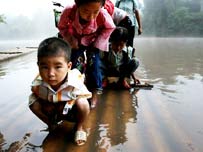 Children from in a mountainous village in Lang Son Province cross a river twice a day to go to school.
Children from in a mountainous village in Lang Son Province cross a river twice a day to go to school.
-
The ministry this week sent a note to city and provincial Departments of Education and Training, asking them to try teaching swimming for primary students, especially those in fourth grade, local newswire VietnamNet said Thursday.
Schools were asked to train their physical education teachers and build and share swimming pools, depending on the amount of space and finances available.
The children should be taught swimming on the weekend, during summer vacation or in physical educations classes if possible, the ministry said in the note.
The ministry will subsequently take into account swimming instruction when evaluating the performance of the city/provincial education departments.
Story from Thanh Nien News
Published: 12 February, 2010
Posted by Guillaume on 02/20 at 01:52 AM
(1) Comments •
Permalink
Friday, February 19, 2010
Myanmar : Half a Million Still Homeless in Delta / IOM
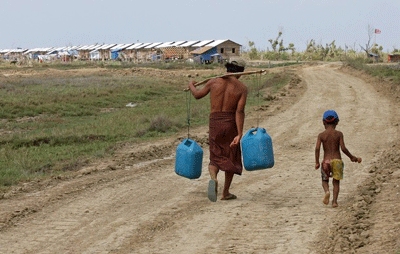
A man carries jerrycans in April 2009 toward a recently-built housing estate for survivors of Cyclone Nargis in Pyinsalu town in the Irrawaddy delta
GENEVA—The International Organization for Migration (IOM) says 500,000 people in Burma are still homeless after a devastating cyclone swept across the southwest of the country nearly two years ago.
IOM spokesman Chris Lom says the affected people have not been able to buy supplies to rebuild their houses because they need to spend the money on food.
He says the agency’s reconstruction program in the Irrawaddy delta is running out of money.
Lom said on Tuesday the agency is appealing for US $17 million to give basic shelter to about 250,000 people in the region. He said other aid agencies are trying to set up shelter for the rest of the homeless.
Cyclone Nargis killed nearly 140,000 people in the South Asian nation in May 2008 and left some 2.4 million without a home.
Posted by Guillaume on 02/19 at 10:23 AM
(0) Comments •
Permalink
Thursday, February 18, 2010
Sarkozy visits Haiti, unveils major aid package
* Package includes new funds, equipment, debt annulment
* Sarkozy is first president of France to visit Haiti
* France to participate in March donors’ meeting on Haiti (Recasts, adds details, quotes, background)
PORT-AU-PRINCE, Feb 17 (Reuters) - French President Nicolas Sarkozy announced a financial and aid package of nearly half a billion dollars on Wednesday to assist quake-hit Haiti, as he became France’s first head of state to visit the former French Caribbean colony.
The support package totaling 326 million euros ($447 million) included cancellation of 56 million euros of debt, 100 million euros of fresh funds to be provided over two years and 65 million euros to be channeled through the European Union.
“I have come to tell Haiti’s people that they are not alone ... France will be at your side in the long term,” Sarkozy told a news conference in the grounds of the Haitian presidential palace which partly collapsed in the Jan. 12 earthquake.
More than 200,000 people were killed and more than a million left homeless by the quake, one of the most destructive in modern history, which has triggered a big international relief effort and reconstruction plans by foreign donors.
Speaking alongside Haitian President Rene Preval, Sarkozy said his visit, the first ever by a French president to Haiti, aimed to “turn the page” on France’s long history of troubled relations with its former Caribbean territory.
Haiti wrested its independence from France in 1804 after a bloody revolt by black slaves against their white masters.
Speaking earlier at the French embassy in Port-au-Prince after flying by helicopter over the worst-damaged areas of the city, Sarkozy ruled out any idea of “international stewardship” over Haiti while foreign donors assisted in its recovery.
“International aid must be massive and be there for the long term,” he said, while stressing that the recovery project would remain under the control of the Haitian government.
In a sprawling tent city housing thousands of quake survivors in front of the palace, a group of demonstrators, supporters of former Haitian President Jean-Bertrand Aristide, staged a protest against Preval’s government and against the French president’s visit.
But other Haitians said they were happy Sarkozy had come to help Haiti rebuild after the catastrophic natural disaster.
“Our ancestors built our independence and France was angry, but that’s forgotten now and Mr. Sarkozy has come to give millions to Haiti. That will encourage other leaders to come to help us,” said Guillaume Imondial, 29, as he peered through the iron railings of the damaged palace.
“REFOUND” HAITI
The French presidency said in a statement French assistance would include the supply of 1,000 tents and 16,000 tarpaulins to shelter 200,000 homeless people during Haiti’s rainy season, which typically begins in late March or April.
France also will provide 10 experts to work with Haiti’s Prime Minister and his staff on the recovery effort for two years. Other experts will undertake short-term missions.
In addition, France will rebuild a university hospital and carry out a preparatory study to reconstruct the badly damaged ornate, white presidential palace in Port-au-Prince.
Preval thanked Sarkozy for France’s support.
“You came, you listened, you saw,” said the Haitian president, who on Monday held talks with visiting Canadian Prime Minister Stephen Harper.
International donors are providing emergency aid to victims of the quake but are also looking to support Haiti’s long-term recovery to try to pull the Western Hemisphere’s poorest state out of a cycle of poverty and political instability.
“We’re not going to just reconstruct the country, we’re going to build it again, refound it,” Preval said, adding the recovery would seek to bring development to rural areas to ease the pressure on the crowded, shattered capital Port-au-Prince.
France, along with the United States and Canada and many other governments, will participate in a high-level donors conference for Haiti next month in New York.
Economists from the Inter-American Development Bank have estimated the cost of rebuilding Haiti after the quake could reach nearly $14 billion, making it proportionately the most destructive natural disaster in modern times.
Preval has said his government is discussing the creation of a common fund for Haiti’s recovery to be managed in partnership with donors. Dominican Republic President Leonel Fernandez has estimated this fund could total $10 billion over five years. Other leaders say a decade will be needed for rebuilding. ($1=0.735 euro)
Posted by Guillaume on 02/18 at 02:24 AM
(43) Comments •
Permalink
Wednesday, February 17, 2010
GLOBAL: Humanitarian agencies will have to go urban
JOHANNESBURG, 16 February 2010 (IRIN) - How many people live and work in a shantytown? How do you map health clinics or water delivery sources in a slum? Humanitarian agencies will be seeking answers to these and other questions as vulnerable populations settle in a sea of shacks on the outskirts of cities and towns across the world in the next few years, a new report forecasts.
Humanitarian Horizons: A Practitioners’ Guide to the Future, published by the Humanitarian Futures Programme at King’s College, London, and the Feinstein International Centre at Tufts University in the US, is one of two new reports advocating the need for programmes to reduce vulnerability in urban settings. The other is the World Bank’s flagship Development Report 2010.
“Half the world’s people now live in cities, a share that will rise to 70 percent by 2050,” said the World Bank report, citing UN Population Fund statistics. “Of urban population growth (5 million new residents a month), 95 percent will be in the developing world, with small cities growing fastest.”
Most humanitarian efforts and aid have been focused on rural development rather than the needs of the urban poor. About 810 million people already live in city slums, battling overcrowding, insecure tenure, landslides, flooding, poor sanitation, unsafe housing, inadequate nutrition and poor health.
The shift to urban programming will “accelerate the already existing trend within the humanitarian system that has agencies offering less in-kind inputs and more cash” to build resilience.
Other than urban earthquake preparedness, humanitarian agencies have not yet focused on emergency response in urban centres. The authors of the guide offer tips to humanitarian agencies in this new environment:
1) Programming has to shift from being rural-focused, so humanitarians will now have to reach out to urban planners for effective urban programming
2) Build a knowledge base identifying the differences between urban and rural programmes
3) Re-identify and reprioritize groups most at risk
4) Use of technologies such as cell phone banking and microcredit to deliver aid in an urban context
5) Ensure the creation of better linkages between city and town authorities, and strengthen delivery systems
The World Bank report also examines the impact of climate change on urban populations. “Low-elevation coastal zones at risk from rising sea levels and coastal surges are home to about 600 million people globally, and 15 of the world’s 20 megacities.”
The World Bank report lists some useful recommendations of its own:
- Sound urban planning restricts development in flood-prone areas and provides critical access to services.
- Infrastructure developments (embankments or levees) can provide physical protection for many and will require additional safety margins where climate change increases risk.
- Well-established communication, transport, and early warning systems help evacuate people swiftly, as in Cuba, where up to 800,000 people are routinely evacuated within 48 hours when hurricanes approach.
Humanitarian Horizons: A Practitioners’ Guide to the Future http://www.preventionweb.net/files/12689_PractitionersGuideFuture1.pdf_version=1
World Bank Report 2010 World Bank Report 2010
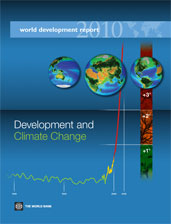
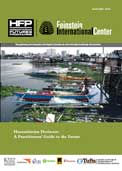
Posted by Guillaume on 02/17 at 01:58 AM
(92) Comments •
Permalink
Tuesday, February 16, 2010
CLIMATE CHANGE: U.N. to Mobilise Funds for Developing Nations
UNITED NATIONS, Feb 15 (IPS) - After countries failed to reach a binding agreement on greenhouse gas emissions at the crucial Climate Change Conference in Copenhagen last December, the United Nations moving forward to enforce a pledge to help developing countries cope with the worst impacts. The launch of the Advisory Group on Climate Change Financing follows the Copenhagen Accord, the final agreement of last year’s meet, part of which states that 100 billion dollars per year will be needed to help developing countries with adaption and mitigation efforts.
Gordon Brown, the British prime minister, and his counterpart from Ethiopia, Meles Zenawi, are co-chairing the group.
“We must take forward now some of the elements of the agreement,” Brown told reporters.
The goal, he said, is to “get the approaching 30-billion-dollar figure for fast start finance for 2010 to 2012 flowing now, to help developing countries immediately tackle and adapt to climate change.”
The figure is then supposed increase and reach 100 billion dollars annually by 2020.
Meeting a Jan. 31 deadline that was also part of the Copenhagen Accord, 62 countries have so far formally submitted to the United Nations their national targets to limit greenhouse gases by 2020. Together, those countries account for more than 80 percent of global emissions from energy use.
“Already we can see that, if promises are met, the accord will lead to the peaking of global emissions by or before 2020 and make it possible for us to hold the trajectory of global temperature to two degrees Celsius,” Brown concluded from those submissions.
One of the main tasks of the newly formed task-force will be to make sure that these promises are met and the funds governments pledged really will flow. But the money should not come only “from taxpayer revenues”, Brown said. The group will be looking into “innovative financing mechanisms”, he stated.
Two of many possible mechanisms to be investigated have long been floated in policy circles. One is a financial transaction tax, of which Brown is an advocate.
That proposed tax would be used for a number of development initiatives. “But it actually happens to also raise resources for a lot of global goals, like dealing with climate change,” Keya Chatterjee, director of the U.S. World Wildlife Fund’s Climate Change Programme.
Another idea would be to divert the money now spent on subsidies for the fossil fuel industry, Chatterjee said. The G20 bloc of large economies agreed in September 2009 to phase out such subsidies, but have not given any specific timetable.
Chatterjee welcomed the launch of the new high-level fundraising group.
“It’s definitively a step forward,” she told IPS. “And really, there isn’t a lot of choice here. It’s just a question of are we going to invest now, at relatively modest amounts, or we going to invest huge amounts of money in the future?”
Developing countries require money in order to cope with the impacts of climate change and in order to prepare for the tasks to come. “These investments are going to save enormous future costs,” Chatterjee explained to IPS.
One example is the worldwide loss of biodiversity. Each year, an estimated 1.5 to 3 trillion Euros is lost due to damage to the planet’s ecological services, the United Nations Development Programme (UNDP) declared on Wednesday.
Another example is natural disasters such as hurricanes, whose frequency and severity is expected to grow in coming years. “If we help countries prepare for the impacts of climate change now, we don’t then have to spend as many resources responding to disasters. We know it’s very expensive to respond to disasters on an ad hoc basis,” Chatterjee told IPS.
U.N. Secretary-General Ban Ki-moon is expected to announce all the members of the advisory panel shortly. Other heads of state will include Guyanese President Bharrat Jagdeo and Norwegian Prime Minister Jens Stoltenberg.
The panel is also supposed to include high-level officials from ministries and central banks, as well as experts on public finance, development and related issues, Ban told reporters at the launch on Feb. 12.
“There will be an even balance between developing and developed countries,” he said.
One important aspect of the group will be transparency within the U.N. system, Chatterjee told IPS. She expects civil society to be well integrated in the work of the task force.
“There’s a real lack of trust” due to pledges that have gone unmet in the last several years, she said, adding that the new advisory panel has an opportunity to rebuild that trust.
Asked whether China would receive any of the money the advisory group will raise, Ban stated that “the Chinese said that they would see this money be used, supported for other developing countries.”
The first report from the advisory group is expected at the United Nations Framework Convention on Climate Change (UNFCCC) meeting in May in Bonn, Germany. The group then will present its final recommendations before the next Conference of the Parties (CoP) to the UNFCCC in Mexico in December.
For that meeting, the goal still is “a legally binding outcome,” Brown said.
To date, the Kyoto Protocol remains the world’s only legally binding agreement on climate change. It requires 37 wealthy nations to cut greenhouse gas emissions by 2012, but asks for no commitments from developing countries.
In contrast, the Copenhagen Accord does not mention hard targets for the developed countries and is seen by critics to be lowering the bar in climate negotiations when scientists warn that the climate is changing more rapidly than previous estimates suggested.
http://ipsnews.net/climate_change/
Posted by Guillaume on 02/16 at 10:19 AM
(42) Comments •
Permalink
Ten percent of relief aid should be allocated to building safer houses, hospitals and schools
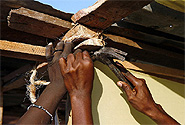
UNISDR Press release 2010/02
Geneva - As relief continues to be the main priority for thousands of Haitians who have been affected by the 7.0 magnitude earthquake in Port-au-Prince, the United Nations International Strategy for Disaster Reduction (UNISDR) and its partners are working together to ensure that disaster risk reduction principles are fully integrated into the different phases of the Haitian reconstruction process.
“More than ever, Haiti is in a vulnerable situation due to the upcoming rainy and hurricane seasons. There is great urgency now to give particular attention to structural safety for temporary schools, hospitals and camp settlements,” said Margareta Wahlström, UN Special Representative of the Secretary-General for Disaster Risk Reduction. “Camps must be built in safe locations with resistant materials and adequate drainage systems to be able to withstand the next hurricane season. The entire international community shares a collective responsibility to reduce the vulnerability of thousands of Haitians to new, imminent disasters.”
In the past decade, Haiti has suffered significant losses from hurricanes. The 2008 season was particularly severe as Haiti experienced four hurricanes in a row. Mudslides are another risk that Haitians may face if rainfalls are significant.
UNISDR is working with donors and UN partners to ensure that Haiti’s schools, hospitals and houses will be rebuilt in a manner that integrates strategic planning to mitigate these multi- hazard risks.
“It will take a minimum of ten years to rebuild Haiti but it is important to start building safer schools, hospitals and critical infrastructure now. It costs much less to integrate disaster risk reduction principles into the design of new construction than to retrofit existing buildings. The 2009 Global Platform on Disaster Risk Reduction recommended allocating ten percent of relief aid to disaster risk reduction. It is our hope that 10 percent of the estimated US$ 10 billion reconstruction effort will focus on reducing Haiti’s vulnerability to disasters, which are a recurring threat to the Haitian people,” said Wahlström.
Just as collapsed buildings and unstable land were the prime contributing factors to the high death toll during the Haitian earthquake, so too is corruption another concern that must be addressed. “We also need to ensure that corruption does not undermine reconstruction efforts, particularly as the building sector in Haiti has witnessed severe corruption cases in the past. Cutting corners and using sub-standard building practices contributed to the significant loss of life,” said Wahlström.
UNISDR and its partners will participate in the revised flash appeal to be launched soon with its partners, and is already working with the entire disaster risk reduction community to ensure that a multi-hazard approach is adopted at the next International Conference for the Reconstruction of Haiti, to be held this April in New York. The secretariat is working with the Caribbean Disaster and Emergency Management Agency (CEDMA), UN system agencies, the IFRC, and the International Code Council to ensure a regional and coherent approach in the Haiti reconstruction.
Notes
The Second Session of the Global Platform on Disaster Risk Reduction (Geneva, 15-19 June 2009) recommended targeting the equivalent of 10 per cent of humanitarian relief funds to disaster risk reduction work. Similarly, a 10 per cent figure was proposed as a target share of post-disaster reconstruction and recovery projects and national preparedness and response plans. Calls were also made for at least 1 per cent of all national development funding and all development assistance funding to be allocated to risk reduction measures.
Date:12 Feb 2010
Source : UNISDR United Nations International Strategy for Disaster Reduction Secretariat (UNISDR)
Posted by Guillaume on 02/16 at 05:48 AM
(47) Comments •
Permalink
“We won’t have Mother with us at Tet this year”
After Ketsana…
Pham Thanh Thao, 14, an 8th grader, has become the mainstay in her family. In late September, Thao’s mother perished during the typhoon that ravaged Quang Ngai province, leaving four children and a sick husband.
The family’s home collapsed during the storm, so Thao and her brothers and sisters have to stay with their grandmother. As the eldest, it has fallen to Thao to take care of her brothers and sisters – Nguyen, 12, Uyen, 6 and Toan, only 2.
Thao’s grandmother told VietNamNet reporters about the family’s tragedy. The night the typhoon came. Thao’s father was lying ill at a hospital in another district. As house flooded and its tin roof threatened to fly apart, Thao’s mother took the children to their grandmother’s house nearby. Then she ran back to move the family’s store of rice onto shelves above the knee-high water.
With a groaning noise, the house shivered and then suddenly collapsed. Thao and her siblings waited anxiously for their mother to return. Alas, that was not to be. The next day, as the flood subsided, neighbors found the 37-year-old woman’s body.
Since then, Thao has taken care of her two brothers, her baby sister and her sick father. In the early days without mother, Thao tried to not cry in front of her brothers and sisters. Even now, if someone unintentionally asks “Where is your mother?” the baby, Toan, will say “Mother is cutting grass in the field”.
The four kids are living with their grandmother at a neighborhood temple. They sleep on straw mats spread on the building’s floor every night.
Thao, 14, said: “I get up at five to cook rice, sweep the house and feed the pigs and chickens. Then I set the table for my brothers and sisters and see that they are properly dressed for school . . . .” Overhearing Thao, one would hardly think she is so young.
Thanks to her big sister’s training, Nguyen can wash his own clothes while Toan can dish up rice himself. Not just taking care of housework, Thao also is trying to study well to be a good example for her brothers and sisters. Before going to bed, she prepares books and pens for the kids.
These children are surviving on the produce of a small garden and a few million dong of Government assistance received after the typhoon that their grandmother husbands to pay school fees.
As the people of Binh Minh village prepared for Tet, Thao’s grandmother didn’t dare talk with the children about the approaching holiday, fearing that they would miss their mother even more. “I’m very worried about their future,” she confided. “I’m growing old, and my poor, sick son can no longer do farm work.”
And what is Thao’s dream? To cover her sadness, the girl looked away, toward the foundation of the family’s ruined home, and said – as tears fell – that she hopes only that her father will regain his health and her brothers and sisters can continue to go to school like other kids. That’s enough – and sadly, even that modest dream may be beyond the strength of this young girl!
Posted by Guillaume on 02/16 at 02:51 AM
(134) Comments •
Permalink
Monday, February 15, 2010
Year of Tiger 1/1/10 #14th February 2010



Posted by Guillaume on 02/15 at 05:47 AM
(91) Comments •
Permalink
Saturday, February 13, 2010
Global: A peak into the humanitarian future
JOHANNESBURG, 12 February 2010 (IRIN) - Not too far in the future - say, about 15 years, by which time the impact of climate change might have escalated tenfold - the day could come when the humanitarian community would have to provide water and food to millions of people in drought-affected Africa, tend to a few hundred thousand after a cyclone in Asia, and deal with another “Haiti” - all at the same time.
“Do you think the humanitarian community would be able to cope?” asked Randolph Kent, director of the Humanitarian Futures Programme at King’s College, London, and co-author of Humanitarian Horizons: A Practitioners’ Guide to the Future.
Not unless they reinvent themselves. But the shift has begun, and long-standing views of how disasters play out are being challenged. “No longer are humanitarian activities limited to immediate response and post-conflict recovery,” the guide noted.
For some time the humanitarian community has tried to address both the “‘causes’ and the ‘effects’ of disasters, leading to an increasing number of humanitarian interventions that look more and more like traditional development activities”.
Kent and the co-author of the guide, Peter Walker, director of the Feinstein International Centre at Tufts University in the US, predicted the emergence of a “new humanitarianism”, in which the humanitarian agenda would expand to include governance, livelihood, security, social protection, and other development-like activities. Addressing vulnerability would become the key focus.
The guide also forecast that developing-country governments, particularly in Asia, would become more involved in national social protection programmes and seek open-ended support. Walker said in that context local humanitarian agencies “will grow, and international agencies may have to become more willing to be led by their local members/branches.”
Paul Harvey, a humanitarian aid consultant, said he foresaw the re-emergence of the primacy of the state in addressing disasters. He noted that over the years aid flows to developing country governments had shifted to humanitarian agencies, “but recently the funds have begun to flow to governments directly with the emergence of countries such as Indonesia, Indian and China capable of responding to natural disasters.”
The guide suggested that a new three-part humanitarian organization could be on the cards, with one part devoted to providing impartial aid in and around conflict zones; another to development assistance in areas of the world where poverty was rife but the state was stable; and a third part focusing on uncertain, disaster-prone, crisis-driven “fragile” states.
How to make it happen
What would it take for a humanitarian organization to adapt? “Two things ... the key is becoming far more aware of context and being evidence- rather than anecdote-driven,” Walker told IRIN.
“If we are honest, we have seen a drift towards being over-concerned with financial accountability, meeting the deliverables of government contracts, and meeting internal standards. This needs to be balanced with a far greater push for local evidence, and this means moving much more authority into the field,” he said.
“Second, in many places, rather like with the safety net system in Ethiopia, humanitarian agencies will have to choose between being independent emergency players and long-term providers of welfare, working closely with government systems. It is not a matter of right or wrong; both are legitimate, but they call for very different types of agencies.”
Kent had six tips for aid agencies:
1) Become more anticipatory so you need less time to plan
2) Become more adaptive and agile
3) Consider collaborations with scientists and academics to improve analytical capacity, broaden understanding of the complexities of societies and communities, and get a new perspective on possible future scenarios
4) Engage in more collaboration with the corporate sector and the military. “The military spends 90 percent of its time on strategic analysis,” he pointed out.
5) Keep up to date with innovations such as Plumpy’nut, the ready-to-use therapeutic food that has revolutionized the treatment of severe malnutrition in children.
6) More strategic leadership with vision is needed. Kent said the humanitarian community had moved from an “advocacy, and morally driven” approach, to “being increasingly driven by managerialism”; it was time to bring advocacy and vision back.
Where would this leave the United Nations? Kent commented: “Broadly speaking, I feel that when it comes to humanitarian affairs, the UN has to become more of a standard-bearer, online coordinating facilitator, an innovations catalyst, and an active advocate about future vulnerability and solutions.”
Posted by Guillaume on 02/13 at 06:20 AM
(44) Comments •
Permalink
Friday, February 12, 2010
EU military mission to provide shelter in Haiti
* EU to send military mission, increases aid
* Says shelter urgent need ahead of rainy season
BRUSSELS, Feb 11 (Reuters) - The European Union plans to send a military mission to Haiti to provide shelter for earthquake victims and pledged another 90 million euros ($124.1 million) of humanitarian aid to the country on Thursday.
“Shelter is the most burning need,” EU foreign policy chief Catherine Ashton said in a statement at an EU summit in Brussels, adding that the aim was to deploy the military mission before the March rainy season in Haiti.
She did not say how many EU troops would be involved, but said Haiti’s government and the United Nations had requested the military mission.
An EU statement said the bloc was allocating another 90 million euros from its emergency reserve to help provide shelter for people who lost their homes in the earthquake and to assist food distribution and healthcare.
“We should avoid at all costs a second-wave humanitarian disaster in Haiti. With the approaching rainy and hurricane season, giving people a roof over their heads is a key priority,” said EU aid commissioner Kristalina Georgieva.
“It needs to be a roof that can withstand the Caribbean storms,” she said. “The experience of 2008, when the country was hammered by four tropical storms in succession, is very much in our minds.”
Last month, EU institutions and member states offered more than 400 million euros in emergency and longer-term aid to Haiti and the bloc deployed paramilitary police to help protect the relief effort.
In the immediate aftermath of the disaster some EU members compared the European response unfavourably to that of the United States, which quickly deployed tens of thousands of troops and vast food and aid supplies.
Posted by Guillaume on 02/12 at 02:56 AM
(94) Comments •
Permalink
Thursday, February 11, 2010
Chính phủ Pháp hỗ trợ 50.000 € thực hiện dự án “Tái xây dựng sau bão Kets

Nhà chống bão của DWF xây dựng tại TT Huế - Ảnh minh họa
Ngày 08/02, UBND tỉnh Thừa Thiên Huế đã quyết định phê duyệt tiếp nhận dự án “Tái xây dựng sau bão Ketsana ở tỉnh Thừa Thiên Huế” do Chính phủ Pháp tài trợ thông qua tổ chức Development Workshop France (DWF).
Dự án sẽ thực hiện hỗ trợ các gia đình thuộc xã Lộc Trì, huyện Phú Lộc và xã Phú An, huyện Phú Vang bị ảnh hưởng nặng nề do bão Ketsana tái hòa nhập cuộc sống một cách hoàn chỉnh và an toàn cũng như cải thiện điều kiện sống và đóng góp vào chính sách phòng ngừa trong tương lai. Trong đó, tái xây dựng và sửa chữa 50 ngôi nhà; xây dựng đê bảo vệ thôn tại xã Lộc Trì; hỗ trợ tái thiết các hoạt động kinh tế cho các hộ ngư dân với tổng kinh phía tài trợ là 50.000 Euro
http://www.thuathienhue.gov.vn
Posted by Guillaume on 02/11 at 11:33 AM
(98) Comments •
Permalink
Tuesday, February 09, 2010
Earth Hour 2010 Vietnam seeks greater climate change awareness
Vietnam on Thursday officially launched the World Wildlife Fund’s Earth Hour 2010 campaign in the country, seeking to expand participation in what is touted as the world’s largest awareness movement on climate change.
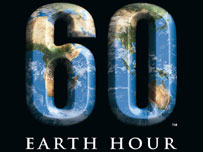
More than 20 cities and provinces will hopefully get on board this year, the WWF and the Department of Meteorology and Climate Change of the Ministry of Natural Resources and Environment said in a press release.
There will be a “spectacular” event in HCMC, hosted and attended by celebrities and high-profile Earth Hour Ambassadors as well as a fashion show of Earth Hour T-shirt designs.
All Vietnamese citizens and businesses are being urged to participate by turning out lights and shutting off appliances for one hour from 8:30 p.m. on March 27, the organizers said.
The Mega City Mega Stress Report and Mekong Delta Climate Change Report of 2009 shows how vulnerable Vietnam has become to changes brought by global warming.
“Extreme weather events are occurring more often, rivers and flood plains are drying up and coasts are being eroded,” the release noted.
“Because Vietnam is especially vulnerable, it is ever more important the country has a loud and powerful voice on the global front in the fight against climate change, and contribute to international community effort in keeping the global temperature rise under 2 degrees Celsius,” said Tran Minh Hien, director for WWF Vietnam.
“We need to stand up to this threat.”
Electricity of Vietnam (EVN), the national power utility, will take part in many activities as an official partner of Earth Hour 2010.
WWF says Earth Hour 2010 is more than about turning out the lights for an hour. It is to raise awareness on climate change by engaging people in the symbolic action.
High-profile Earth Hour Ambassadors will visit schools bringing the Earth Hour message and competitions on climate change topics will be organized.
Earth Hour started in Sydney in 2007 and has become a global movement in the last two years. In 2009, the campaign was joined by around one billion people from 4,013 cities in 88 countries.
In Vietnam, Earth Hour 2009 was held for the first time in six provinces and localities - Hanoi, Ho Chi Minh City, Can Tho, Hoi An, Hue and Khanh Hoa City - gathering hundreds of individuals, businessmen and organizations.
Source: Thanh Nien
Story from Thanh Nien News
Published: 06 February, 2010
Posted by Guillaume on 02/09 at 03:39 AM
(2817) Comments •
Permalink
Monday, February 08, 2010
Reconstruction programme in Loc Tri (Thua Thien Hue) Opening Ceremony 8th February 2009
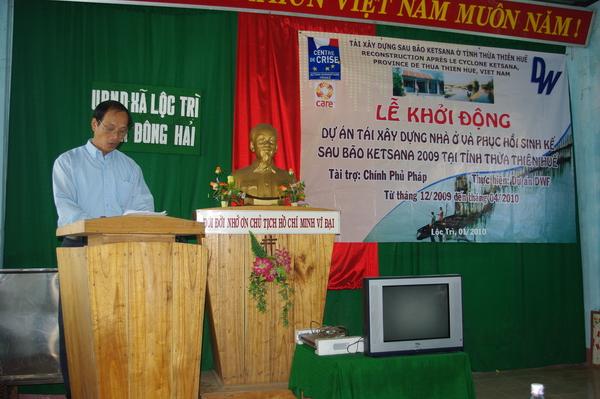
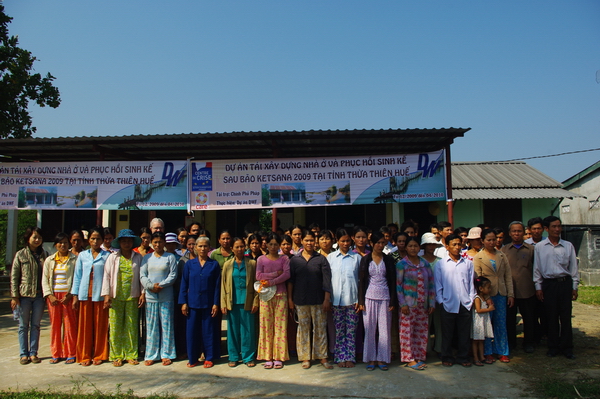
Posted by Guillaume on 02/08 at 05:04 AM
(31) Comments •
Permalink
Haiti protesters denounce aid corruption, hoarding
* Demonstrators say district mayor hoarding quake aid
* Food distribution has been sometimes slow, chaotic
* President estimates some 250,000 killed in quake
PORT-AU-PRINCE, Feb 7 (Reuters) - Hundreds of Haitian earthquake survivors protested in a suburb of the wrecked capital on Sunday, accusing a district mayor of corruption and hoarding food aid provided by relief groups, witnesses said.
The protest in the Petionville neighborhood of Port-au-Prince was one of the largest since the Jan. 12 quake that killed more than 200,000 people and left over 1 million homeless. It reflected still simmering anger among survivors over problems in the massive international relief effort.
Aid agencies from around the world have moved tons of rice and other food into Haiti but distributions to the hungry and homeless have been slow and sometimes chaotic.
Banging on plastic buckets and waving branches and palm fronds, the protesters surged past piles of earthquake rubble—and a woman bathing by the side of the road—to the city hall in Petionville, where they accused Mayor Lydie Parent of hoarding aid.
“I am hungry, I am dying of hunger. Lydie Parent keeps the rice and doesn’t give us anything. They never go distribute where we live,” one protester said.
Parent was not immediately available for comment.
Most of the demonstrators were women. Aid agencies are doling out food to women to prevent men from dominating distribution sites, and because they believe women are more likely to share it with children and relatives.
Donor nations have poured tens of millions of dollars into the impoverished Caribbean nation and some Haitians have blamed corruption for the sometimes sluggish distribution of aid.
Sacks of donated rice have turned up in local street markets. Aid officials said it was inevitable that some aid would find its way to the black market in Haiti, which was ranked 10th from the bottom of Transparency International’s latest corruption rating of 180 nations.
1 MILLION NEED SHELTER
Haitian President Rene Preval, who has been seen only occasionally in public since the quake, has been targeted by some protests, and graffiti messages of “Down with Preval” have been scrawled on some buildings and walls.
“We are all victims. It is a fallen country. It has lost its children, husbands, homes and family,” protester Agustin Michou said.
The demonstrators chanted “if the police shoot at us, we will burn everything,” but the protest ended peacefully and police did not intervene.
During a visit by senior Dominican Republic officials to Port-au-Prince over the weekend, Preval said he estimated some 250,000 people had been killed in the quake, and 250,000 houses were destroyed.
He added that a million homeless people urgently needed to be relocated in temporary shelter before the rainy season, which normally begins in March.
But he recognized that many quake victims would want to remain close to their original places of residence. “This is their neighborhood, their environment, they won’t want to leave those places,” he said.
In an interview with CNN’s Candy Crowley on Sunday, U.S. Secretary of State Hillary Clinton said she and her husband, former U.S. President Bill Clinton who is the United Nations special envoy and relief coordinator for Haiti, were committed to helping the earthquake-ravaged country.
“We have a special place in our heart for Haiti having gone there during our honeymoon many years ago. And it’s a place that is captivating. The people are so resilient. And they deserve so much better that what they’ve gotten over their history,” Hillary Clinton said.
The U.S. military, backed by a flotilla of warships and a fleet of aircraft flying in supplies, has been spearheading the international relief effort.
Posted by Guillaume on 02/08 at 05:00 AM
(119) Comments •
Permalink
Saturday, February 06, 2010
At World Bank, Haiti recovery is mapped out
Source: Reuters
*Situation room set up to help Haiti recover
*Quake killed estimated 30 to 40 percent of civil servants
*Experts look beyond rebuilding capital
Download
Map of destruction in Port of Prince
WASHINGTON, Feb 4 (Reuters) - In the heart of Washington, a room full of satellite imaging and aerial photographs is where the monumental task of rebuilding Haiti begins.
The Haiti Situation Room at the World Bank contains materials assembled by thousands of volunteers from 103 organizations including universities, government and private aid agencies, and companies helping the earthquake-devastated nation.
The software specialists, scientists and technicians from around the world have joined disaster experts and urban planners at the World Bank, the poverty-fighting institution that will be play a major role in helping Haiti recover.
“For the first time the world is responding to a crisis in a 21st Century way,” says Joaquin Toro, a senior disaster risk management specialist at the World Bank.
“The technology allows us to have a big picture of what happened without having to spend a month or two months on the ground,” Toro said.
Flying over Haiti several times a day, aircraft equipped with optical laser sensors and high-definition imagery have gathered aerial photographs of the devastation in which as many as 200,000 people have died.
Downloaded to a server of the University of Puerto Rico, then transferred to the Rochester Institute of Technology, the images are processed and sent to the team at the World Bank.
In the Situation Room, Galen Burr Evans, a World Bank urban development specialist, examines an aerial photograph of the broken capital Port-au-Prince. He touches a screen mounted on a wall and it quickly zooms in on a damaged building he identifies as a hotel. The images are so sharp that it is easy to see people in the street carrying water buckets.
“With that type of detail we can do analysis of the level of damage, whether buildings are completely destroyed, or just heavily damaged,” Evans said.
ZONING IN ON DISASTER
By working with groups like Google, Yahoo, NASA and Microsoft, ImageCAT and the Earthquake Engineering Research Institute, Evans said the World Bank had halved the preparation time for disaster damage assessments.
He said improved technologies for satellite imagery allowed experts to figure out objects as small as 15 centimeters (6 inches) in size on the ground in Haiti.
Francis Ghesquiere, a disaster risk expert who will lead the World Bank’s damage assessment in Haiti, said recovering from such a major disaster would take a massive international effort led by the Haitian government.
The first challenge, he said is to ensure the government, which is operating out of a police station in the capital, was able to function properly to lead the recovery.
Ghesquiere said 30 to 40 percent of all senior civil servants in Haiti died in the earthquake, which struck between 4 p.m. and 5 p.m. on Jan. 12 when junior civil servants had left for the day but most senior officials were still at work.
Equipped with maps and photos from the Situation Room, Ghesquiere will travel to Haiti this week to prepare for the formal multi-national damage assessment starting on Monday.
In Port-au-Prince teams of international engineers will examine buildings to see which are safe and which are not. Separately, other experts will do an inventory of damage to different sectors of the economy including health, education and transport.
It is early days in the reconstruction of Haiti, but Ghesquiere said this is an opportunity to rebuild a country better than before.
As experts survey the damage, many of them are already talking about rebuilding an entirely new country and resettling people in safer and better constructed cities.
“We can’t look at this reconstruction as purely rebuilding Port-au-Prince, it has to be a vision for the entire country,” Ghesquiere added.
Posted by Guillaume on 02/06 at 01:12 AM
(51) Comments •
Permalink
Tuesday, February 02, 2010
Viet Nam: Australia, ADB Help Protect Viet Nam’s Mekong Delta from Climate Change
MANILA, PHILIPPINES - Viet Nam’s low-lying and flood-prone Mekong Delta region will get support from Australia and the Asian Development Bank (ADB) to help cope with the potentially devastating impacts of climate change.
Technical assistance grants totaling $1.3 million from the Government of Australia and ADB will be used to carry out a full assessment of the climate change threats posed to the Mekong Delta region, and the actions needed for it to adapt in the face of an expected sea-level increase and more frequent and severe floods.
Viet Nam is one of the nations most at risk from climate change, and the Mekong Delta in the south, which is home to a fifth of the population, and the main producer of rice, is the most vulnerable region in the country. Preliminary studies show that up to 31% of the total land used for agriculture and aquaculture in the delta is at risk from a potential one meter rise in the sea level by 2100. This would have severe effects on the lives of about 4.8 million people, including over a million and a half poor.
A number of development agencies are providing climate-change linked assistance to Viet Nam, but there has been no comprehensive study undertaken of the potential impacts of extreme climate events on the Mekong region.
“Effective climate change adaptation measures urgently need to be developed and integrated into the region’s development planning to enhance the physical and economic climate-resilience of the region and to protect poor and rural households,” said Yongping Zhai, Lead Professional Energy Specialist in ADB’s Southeast Asia Department.
The technical assistance will have two parts – Part A will involve modeling and assessment work to determine the likely future climate conditions in the region and their impact, and Part B will identify appropriate climate change adaptation measures for targeted areas and sectors. In particular, Part B of the technical assistance aims to establish pilot projects for adaptation actions that could be scaled up and replicated in other provinces or sectors in the region.
The areas selected for detailed analysis and piloting under the project are the coastal provinces of Kien Giang and Ca Mau, while the sectors chosen are energy, transport and agriculture, with the latter at the center of Viet Nam government’s own national action plan for climate change adaptation.
The total cost of the project is $1.63 million equivalent, with the Government of Australia, providing an $800,000 grant, which will be administered by ADB. ADB is supplying $500,000 from its Climate Change Fund, while the Government of Viet Nam will provide the remaining $330,000. The Ministry of Natural Resources and Environment is the executing agency for the project which will be carried out from January 2010 to April 2011.
Source: http://www.adb.org/ (ADB)
Date: 13 Jan 2010
Posted by Guillaume on 02/02 at 06:47 AM
(43) Comments •
Permalink
Monday, February 01, 2010
Transparency International moves to stem corruption in Haiti aid effort and beyond
LONDON (AlertNet) - Transparency International (TI) is working on setting up an aid monitoring project for Haiti to prevent corruption in the relief effort, the group said on Monday as it launched a handbook to help aid agencies combat practices that stop help from reaching the needy.
TI is already in discussion with major donors to Haiti about the project, which the anti-corruption watchdog feels is vital given the country’s history of graft, the desperate state of its population after the Jan. 12 earthquake and the logistical problems of the relief effort.
“Just as in the (Asian) tsunami, there’s a huge amount of resources going in and it’s really important that someone is keeping an eye on it,” said Roslyn Hees, a senior TI advisor and co-author of the handbook called “Preventing Corruption in Humanitarian Operations”.
“It’s what I’d call a perfect storm for high corruption risk: you have a seriously damaged institutional infrastructure, a country with endemic corruption, a weak or fragile state in the best of circumstances and sudden influxes of huge amounts of resources to a highly vulnerable population,” Hees told AlertNet from Geneva.
The 7.0 quake killed as many as 200,000 people in the Caribbean country and left hundreds of thousands homeless. Billions of dollars have been raised for the relief effort.
Before the quake, TI rated Haiti’s government as one of the world’s corrupt and least effective countries and Haitians have already expressed concern about aid not reaching the people who really need it.
Last year, Transparency ranked the country 168th out of 180 nations on its annual Corruption Perceptions Index.
The Haiti aid monitoring project could be up and running within a month or two, provided TI secures funding and is able to bring in some outside expertise to help support its small Haiti chapter, which is currently working with a civil society coalition.
“Obviously we’re not going to monitor the entire aid. We’d have to be working with the major donors to do sampling,” Hees added.
PRACTICAL TOOL
Given the challenges of the Haiti relief and recovery effort, TI’s handbook comes at an opportune moment.
It grew out of the 2004 Indian Ocean tsunami when huge amounts of money were raised for the affected countries but not all the funds reached those in need or were put to good effect.
“The objective is to give aid agencies a very practical, hands-on tool,” Marie-Luise Ahlendorf, co-author of the handbook, told AlertNet. “It’s a compilation of good practices and tools to help agency staff both at headquarter and field level to prevent corruption in their operations.”
TI acknowledged that anti-corruption practices are not the first priority in the immediate aftermath of a disaster the scale of Haiti but that they are vital in later stages.
“There is a moment ... where things are so difficult that humanitarian agencies really do have to take shortcuts and just do anything they feel is necessary to try and get aid to people because at that stage lives are generally at stake,” said Hees.
“Once you move from that immediate stage of extreme danger and risk into what I would call the recovery, reconstruction and rehabilitation stage, it’s probably worth taking the time to set things up and do them properly,” she added.
Corruption in the humanitarian sector can cost lives or worsen the living conditions of the very people the aid is designed to help.
Sometimes money raised is not spent on relief but goes into people’s pockets. Other times, goods and services are correctly procured and taken to the relevant sites but that they are given to the wrong people, said Hees.
Aid can also be misused, as was seen amongst West African refugees in 2001, who were forced to give sexual favours in return for relief - one of the case studies in the handbook.
In Aceh, following the 2004 tsunami, thousands of families were left without homes after contractors employed by Save The Children built houses without foundations. The discovery prompted Save The Children to overhaul its construction policy and to root out corruption, the handbook said.
The handbook was compiled with the help of seven humanitarian partners as well as researchers and took some four years to put together.
Despite all the research that went into it, however, TI has no way of knowing how endemic corruption is in the global relief effort, Hees said. It will also be difficult, therefore, to know how successful the handbook has been in preventing it.
But TI hopes aid agencies can use it to strengthen their own existing anti-corruption structures and that they will also add to it as new information arises.
Here are some of key recommendations made in the handbook:
* Bring the discussion of corruption into the open, break the taboo around it that inhibits people from taking action such as whistle-blowing
* Understand what corruption is in different cultural contexts
* Note that corruption is not only confined to financial mismanagement and fraud. Nepotism, cronyism, sexual exploitation and the diversion of aid resources to non-target groups are also corrupt practices.
* Integrate the identification of corruption risks into emergency preparedness. Build it into inductions and staff training.
* Ensure there is group decision-making and careful vetting when selecting humanitarian staff, partners and suppliers
* Use civil society organisations such as TI national chapters to help with independent monitoring and evaluation
* Information should be shared between humanitarian organisations on anti-corruption practices systematically and the problem should be addressed jointly
For more humanitarian news and analysis, please visit http://www.alertnet.org
Posted by Guillaume on 02/01 at 10:21 PM
(344) Comments •
Permalink
Disaster Myths
[source: WHO, Myths and realities in disaster situations, http://www.who.int/hac/techguidance/ems/myths/en/]
Myth: Disasters are random killers.
Reality: Disasters strike hardest at the most vulnerable group, the poor—especially women, children and the elderly.
Myth: Epidemics and plagues are inevitable after every disaster.
Reality: Epidemics do not spontaneously occur after a disaster and dead bodies will not lead to catastrophic outbreaks of exotic diseases. The key to preventing disease is to improve sanitary conditions and educate the public.
Myth: The fastest way to dispose of bodies and avoid the spread of disease is through mass burials or cremations. This can help create a sense of relief among survivors.
Reality: Survivors will feel more at peace and manage their sense of loss better if they are allowed to follow their beliefs and religious practices and if they are able to identify and recover the remains of their loved ones.
Myth: Foreign medical volunteers with any kind of medical background are needed.
Reality: The local population almost always covers immediate lifesaving needs. Only medical personnel with skills that are not available in the affected country may be needed.
Myth: Any kind of international assistance is needed, and it’s needed now!
Reality: A hasty response that is not based on an impartial evaluation only contributes to the chaos. It is better to wait until genuine needs have been assessed.
Myth: Disasters bring out the worst in human behaviour.
Reality: Although isolated cases of antisocial behaviour exist, the majority of people respond spontaneously and generously.
Myth: The affected population is too shocked and helpless to take responsibility for their own survival.
Reality: On the contrary, many find new strength during an emergency, as evidenced by the thousands of volunteers who spontaneously unite to sift through the rubble in search of victims after an earthquake.
Myth: Things are back to normal within a few weeks.
Reality: The effects of a disaster last a long time. Disaster-affected countries deplete much of their financial and material resources in the immediate post-impact phase. Successful relief programs gear their operations to the fact that international interest wanes as needs and shortages become more pressing.
Posted by Guillaume on 02/01 at 03:33 PM
(5142) Comments •
Permalink
GLOBAL: Earthquakes - the decade’s deadliest killer
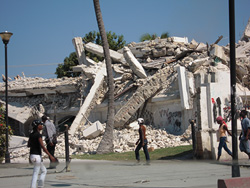
Earthquakes are sudden, intense and unpredictable
JOHANNESBURG, 28 January 2010 (IRIN) - Earthquakes killed more people in the last 10 years than any other natural hazard, said new figures released by the Belgium-based Centre for Research on Epidemiology of Disasters (CRED) a few weeks after the recent quake in Haiti, in which more than 112,000 people are known to have died so far.
Almost 60 percent of the people killed by natural disasters between 2000 and 2009 perished in earthquakes, followed by 22 percent in storms, and 11 percent as a result of extreme temperatures.
On the other hand, floods affected 44 percent of the two billion people struck by disasters, and droughts affected 30 percent, while earthquakes affected only four percent.
Femke Vos, a CRED researcher, pointed out that because earthquakes were sudden and had an immediate impact, they claimed more lives than other slower-onset natural hazards, such as flooding and droughts, where people had time to prepare or adapt.
Lives lost in decade’s deadliest disasters
Indian Ocean Tsunami 226,408
Cyclone Nargis 138,366
Sichuan earthquake 87,476
Pakistan earthquake 73,338
Heat waves in Europe 72,210
Source: CRED
“The area over which earthquakes leave their footprint is also comparatively small in relation to, say, floods or cyclones, which destroy vast areas but cause fewer direct deaths,” said CRED director Debarati Guha-Sapir.
CRED figures for earthquake casualties included the Indian Ocean tsunami caused by an undersea quake in 2004, which left 226,408 dead and has been billed as the deadliest disaster of the 2000 decade.
Eight of the world’s 10 most populous cities lie on tectonic fault-lines: Japan’s capital, Tokyo; Mexico’s capital, Mexico City; New York in the US, Shanghai in China, Jakarta in Indonesia, and three cities in India - Mumbai, Kolkata, and the capital, Delhi.
“Since 1900, four of every five deaths caused by earthquakes have occurred in developing countries,” according to the website of GeoHazards International, a US-based NGO working to improve earthquake safety.
“In the year 1950, two of every three people living in earthquake-threatened cities lived in developing countries; by 2000, that number had increased to nine of every ten.”
Many developing countries do not have building codes; in those that do, the codes are often not enforced. “Experts in earth science and earthquake engineering in developing countries are few in number, ill-equipped, and isolated,” GeoHazards said.
Haiti
Margareta Wahlström, the Special Representative of the UN Secretary-General for Disaster Risk Reduction, noted that “Disaster risk reduction is an indispensable investment for each earthquake-prone city and each community,” in the CRED press statement.
“Risk reduction will be a main priority in the Haiti reconstruction process, and we will be working with our partners to ensure that it is central in the reconstruction,” she said.
“Earthquakes generally have long return periods and in Haiti the return period for this level is, I believe, about a 100 or more years. The main issue in Haiti is not so much reduce their risk to seismic shock, but reduce the crushing poverty that is cause of most of their deaths,” Guha-Sapir told IRIN.
“The issue is: How do we ensure that the victims survive the next years? It’s a country with little basic services and high child mortality. We must ensure these basic life-saving services are in place for the population. That is a priority.”
See CRED_Disasters_2009.pdf
Posted by Guillaume on 02/01 at 03:28 PM
(44) Comments •
Permalink
Vietnam hub fear rising tides as Tet approaches
Residents in Ho Chi Minh City’s District 8 built a makeshift dike with sand bags to prevent high tides from flooding their homes. A project to tackle floods is still in the pipeline but won’t fix the problem before Lunar New Year, which falls on February 14.
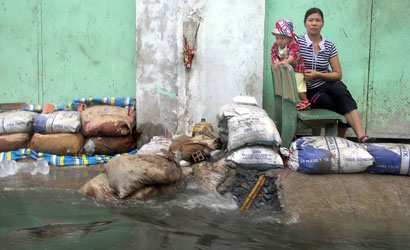
High tides are likely to submerge city’s low-lying streets again over the holidays
Nguyen Huu Loc is praying his street won’t flood for Tet this year.
“Last Tet, we didn’t want to go around because the water levels on the street submerged half my motorbike’s wheel,” lamented the District 8 Ho Chi Minh City resident.
Loc and his neighbors, as well as other residents in the city’s several lowland areas, regularly suffered floods caused by high river tides twice every month. They usually reach their peaks on the first and 15th days of each lunar month, which means they’ll be high on the first day of the Lunar New Year, or Tet, which falls on February 14 this year.
Loc’s hope for a dry holiday will likely go unfulfilled this year as city authorities have yet to complete several construction projects designed to prevent floods, which are expected to be worse this year than normal.
Bad to worse
The Southern Hydro Meteorological Forecasting Center has predicted that two phases of extra-high tides will hit HCMC late January and mid-February respectively. Their peaks are expected to reach the city on January 29 and on February 14.
Government statistics show that around 40 percent of the city’s total area is located below 1.3 meters above sea level, while high tides at Phu An Station on the Saigon River reached 1.56 meters last year.
Do Tan Long, head of the drainage management section at the city’s Flood Prevention Project Management Unit (PMU), said floods will submerge neighborhoods in District 8’s Ward 16 surrounded by the Ruot Ngua and Lo Gom canals for Tet.
A resident of Ward 16’s Neighborhood 5 said they could hardly drive their motorbike through the heavily flooded streets and alleys during high tides.
“This place is just like a small island surrounded by water during high tide,” he said.
A District 8 official said frequent, heavy floods were damaging Phu Dinh, An Duong Vuong and Ho Hoc Lam streets.
Residents at District 6’s Ward 10 and Binh Tan District’s An Lac Ward have also complained of the high tides, which trap them in their homes twice a month.
On January 2, a dike section along the Saigon River in Thu Duc District broke and flooded the houses and apricot gardens of hundreds of families in the area. Local residents said the incident destroyed the gardens and bankrupted many households that had taken out loans to invest in the traditional decorative flower plants for the coming holiday season.
Call to action
The HCMC People’s Committee has instructed city agencies to expedite anti-flood measures before Tet.
All districts, especially riverside areas in Thu Duc and District 12, will have to conduct large-scale inspections of dike systems and enforce weakened sections of the embankments by February 4, according to the committee.
Long from the Flood Prevention PMU said they were preparing to construct dikes along Ben Phu Dinh Street in District 8 and install pumping stations to prevent floods. But he said the project would only begin after Tet.
However, he said a recently-completed project would be able to effectively prevent floods in Binh Tan District’s An Lac Ward and District 6’s Ward 10.
The emergency project had installed one-way valves at 55 sewers and pump stations to prevent tides from overflowing onto the streets.
Long also said several major projects to prevent high-tide floods had been planned, including the construction of a dike system along the Saigon River and along the coastline in Can Gio District. He said another project would also be constructed soon to prevent flooding in districts 1 and 3.
Reported by Mai Vong
Story from Thanh Nien News
Published: 31 January, 2010
Posted by Guillaume on 02/01 at 01:05 AM
(42) Comments •
Permalink
Vietnamese PM proposes an East Asian Forum on Climate Change
VietNamNet Bridge - It is necessary to set up an East Asian Forum on Climate Change where regional countries can work closely to develop joint actions to address this huge challenge of mankind, said PM Nguyen Tan Dung at the World Economic Forum’s special session on East Asia on January 30.
VietNamNet introduces the PM’s full speech:
Today, an East Asian Community of peace, stability, prosperity and progress is gradually taking its shape in reality. Since 1997, regional cooperation and integration towards an East Asian Community have been significantly enhanced under various mechanisms initiated by ASEAN. Important outcomes are recorded in various fields, where economic cooperation and integration are at the forefronts, acting as catalysts and fundamental platforms for the Community building.
Economic and trade ties among regional countries have been further deepened by a network of bilateral and multilateral free trade agreements. The proposals on an East Asian Free Trade Area (EAFTA) among ASEAN+3 countries and a Comprehensive Economic Partnership in East Asia (CEPEA) among 16 countries of the East Asian Summit (EAS) are being considered for realisation. Once established, the EAFTA alone will be the largest Free Trade Area in the world with 2 billion people and US$ 10 trillion in GDP. Another important area of cooperation for an East Asian Community is the improvement of infrastructure connectivity among regional economies. ASEAN is now developing a Master Plan on ASEAN Connectivity to connect road, rail, sea and air routes, telecom and software infrastructure within ASEAN and beyond to East Asia. It is our vision that within the next 20-30 years, East Asia will be a well-connected region where ASEAN plays its centrality.
In terms of mechanism, East Asian cooperation and integration are mainly conducted through ASEAN+3 and the East Asian Summit, in which the ASEAN+3 is considered the main tool with ASEAN at its centre and supplemented by ASEAN+1, ARF and EAS. Apart from these architectures, a number of noteworthy initiatives have been recently proposed, namely the Asia Pacific Community by Australian Prime Minister Kevin Rudd or an East Asian Community by Japanese Prime Minister Hatoyama.
The year 2010 is a pivotal year for ASEAN to step up its Community building efforts. During its ASEAN Chairmanship for 2010 with the theme of “Towards an ASEAN Community: from vision to action”, Viet Nam will work closely with other members to effectively implement the ASEAN Charter, and advance the programmes and roadmap for Community building while expanding and deepening the cooperation between ASEAN and its partners. Viet Nam will also work hard to coordinate and push the ASEAN+3 and EAS cooperation. A dynamic and closely integrated ASEAN will serve as the most important element towards the East Asian Community. In that line, I call upon the developed partners to continue the support and assistance to help ASEAN build its Community by 2015, especially in the efforts to narrow the development gap and increase intra-bloc connectivity.
In my view, in 2010 and beyond, resources should be pooled in order to step up macro-policy coordination, promote sustainable growth in the region, and maintain the economic dynamism of Asia, with focus on the following priorities:
- First, to enhance financial and monetary cooperation, soon implement the agreement on the Chiang Mai Initiative Multi-lateralisation, and improve the resilience of banking systems in the region. It is essential for East Asian countries to make active and practical contributions to the reforms of international financial and monetary institutions and global governing bodies, including the G-20. The Republic of Korea, an East Asian nation, co-hosts the G-20 Summit this year, and this will be an opportunity for East Asia to win a higher profile. ASEAN also looks forward to continued participation at G-20 meetings.
- Second, it is important to push cooperation in the fields of economics, trade and investment, increase the proportion of intra-regional trade and investment, and meet the schedules of free trade areas between ASEAN and China, Japan, Korea, India, Australia and New Zealand respectively. It is high time for East Asian economies to show the strong determination to step up regional and international economic integration, promote trade liberalisation, fight against protectionism, and display an active role to promote an early conclusion of the Doha Round.
- Third, we should work together to improve the infrastructure connectivity in order to facilitate trade and investment as well as people-to-people exchanges. I look forward to the support and assistance from the partners, regional and international organisations to help ASEAN realise its Master Plan on Connectivity, which can serve as the platform to connect East Asia.
- Fourth, it is essential to enhance cooperation in response to global challenges like climate change, food and energy security, environmental degradation, natural disasters and diseases. I believe that ASEAN in particular, and East Asia at large, should take the lead in regional and international efforts against climate change. I would propose an East Asian Forum on Climate Change where we can work closely to develop joint regional actions. The forum might evolve into a global framework to address this huge challenge of mankind. Viet Nam is willing to host the first meeting of such forum in 2010.
- Fifth, the cooperation in culture, tourism, education and the academic and people-to-people exchange should be further promoted to create and nurture the mutual understanding and trust, and improve awareness of the whole community and regional identity. To this end, I urge Japan, China and Korea, the three pillars of East Asia, to set up an East Asian Fund for Education and Cultural Exchange.
Many important pre-conditions for the East Asian Community are put in place. However, due to the diversity of countries in the region, building of an East Asian Community is a big challenge and is a time-consuming process. It is important to bear in mind and make sure that the East Asian Community building is an inclusive process with peace, stability, cooperation, development and common prosperity as its objectives, economic integration as its main tool and ASEAN at its centre. Therefore, apart from pushing economic cooperation, it is essential to promptly address issues that may affect regional security and stability, and pay due attention to promoting confidence building measures. Successful building of East Asian Community is also a precondition for Asia to have a stronger voice in the international arena.
Thank you.
Posted by Guillaume on 02/01 at 12:57 AM
(623) Comments •
Permalink
Saturday, January 30, 2010
Resources from Global Workshop
Network members who have been involved in the ‘Views from the Frontline’ programme met at a Global Workshop on January 25-27 in London, UK to reflect on Views from the Frontline and plan the work of the Network for the next two years.
John Norton, DWF President, participated to this major event.
Click here to see highlights from the conference

Views from the Frontline report
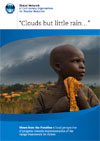
Posted by Guillaume on 01/30 at 04:51 AM
(0) Comments •
Permalink
News from Viet Nam
VietNamNet Bridge – The A/H5N1 virus is reportedly spreading among flocks in the central province of Ha Tinh and the southern province of Ca Mau.
Deputy Minister of Agriculture and Rural Development Diep Kinh Tan said every effort must be made to stop the epidemic, otherwise it would surely spread to other provinces in the Mekong Delta, especially since this is a time of migration.
So far, more than 3,300 poultry birds in Ca Mau province and nearly 700 in Ha Tinh province have been incinerated. Dam Xuan Thanh, Deputy Head of the MARD’s Animal Health Department, said that most of the infected poultry had not received vaccinations.
Tan said the department should cooperate with local authorities to find a way to stamp out the virus.
Meanwhile, Ha Tinh’s vice chairman Tran Minh Ky said that the province has set up check-points to prevent the transportation and slaughtering of poultry flocks in areas hit by bird flu.
Ky said that the province’s poultry flocks would continue to be vaccinated. However, households need to cooperate with authorities and inform them about their poultry so that they can receive timely vaccinations.
Trinh Van Thuan, who owns the largest bird-flu contaminated duck flock in Thanh Quy commune, Ha Tinh province, said his birds also tested positive for the virus.
Nguyen Van Nuoi, head of the Contagious Disease Department at Ha Tinh General Hospital, said that just after the outbreak of avian flu in the province, health officers had started identifying people who had had direct contact with flu-infected birds, so that they could receive testing and treatment.
VietNamNet Bridge – The biggest casino in the country to date opened in the central city of Da Nang on Tuesday.
The casino is part of a major international resort in the coastal city.
The European-style casino occupies 15,000 square meters in the Silver Shores Da Nang resort, which has 548 5-star hotel rooms, 52 high-end villas facing the sea and a 20-hectare international conference center that can host 1,000 people.
It targets tourists from mainland China, Hong Kong and Taiwan. Silver Shores is a joint venture that invested US$160 million in the resort at Khe My Ward in Ngu Hanh Son District.
Construction at the resort started in 2006.
China South Airlines has arranged two flights every Wednesday and Saturday to bring people from Guangzhou to the resort.
Silver Shores also plans to open an airline from Shanghai to Da Nang three months later.
Only people with foreign visas are allowed to enter casinos in Vietnam, including expats and overseas Vietnamese.
Posted by Guillaume on 01/30 at 04:43 AM
(90) Comments •
Permalink
Friday, January 29, 2010
China sea levels reach record high
The sea level in China late last year hit a record high for the past three decades, threatening the safety of thousands of people in the coastal areas, the national ocean agency said yesterday.
The average rise in sea level for the past three decades occurred at a rate of 2.6 mm a year, much higher than the average rate of 1.7 mm annually across the world, a report on the sea-level rise in China for 2009 released by the State Oceanic Administration (SOA) showed.
“Last year, the sea level was 8 mm higher than 2008 with the rise in sea level in Hainan Province reaching 113 mm, the highest across the country,” Lin Shanqing, director of forecast and disaster relief department of the SOA, said yesterday.
Extreme weather like high temperatures and monsoons play an important role in the rise in sea level, Lin said.
In mid August last year, high temperatures hit most parts of southern China, causing the sea level in September to become about 180 mm higher than the previous year and pushing the oceanic temperature to 28.5 C, the second highest record in the past three decades, the report showed.
Experts estimate that the sea level, along the country’s coastal areas, will keep rising and a maximum of 130 mm a year is very possible in the next three decades.
In order to avoid the possible damage caused by the rise in sea level such as storm tides, coastal erosion, seawater encroachment and soil salinization, officials from the SOA suggested authorities of coastal cities improve sea level monitoring systems and take the impact of the rise in sea level into account when making plans for economic development.
“The Yangtze River Delta, the Pearl River Delta, the Yellow River Delta and coastal areas of Tianjin are the country’s most economically developed regions and are potential areas that could suffer from the impact of the rise in sea level,” Xu Sheng, director of the National Marine Data and Information Service, told China Daily.
“Local authorities of the coastal areas should build higher dams and take environmental protection measures to slow down the rise of the sea level,” Xu said.
For island countries such as the Maldives, a sea-level rise of only 1 m is a matter of life and death.
More than 70 percent of the world’s population live on coastal plains and 11 of the world’s 15 largest cities are on the coast or estuaries.
Rajendra Pachauri, chairman of the Intergovernmental Panel on Climate Change, said in Copenhagen on Dec 7 last year that the goal of keeping global temperature increases below 2 C this century would lead to a sea-level rise of 0.4 to 1.4 m. Add on the effect of melting of snow and ice and several small island states and Bangladesh will be submerged.
A number of experts at Oxford University also predicted that a rise of at least 2m in the world’s sea level is now almost unstoppable due to man-made greenhouse gas emission, unless the planet is cooled.
Sea ice scourge to melt in March
The worst sea ice in three decades on China’s eastern coast is expected to melt in March, a senior official from the national ocean agency said yesterday.
“So far, about 35 percent of the water in the Bohai Sea has been covered with ice, about 16 percent less than the peak in mid-January,” said Lin Shanqing, director of the forecast and disaster relief department of the State Oceanic Administration (SOA).
But transportation departments should pay extreme attention to security during the ice-melting season in late February and early March, during which floating ice will endanger passing ships, he said.
The thick ice has been threatening shipping and the livelihoods of fishermen on the country’s eastern coast since late last year and the SOA issued warnings for sea ice on January 13 to avoid any further damage caused by it.
The worst sea ice in 40 years in the Bohai and Yellow seas in early January could cause more than 2.2 billion yuan (US$323 million) of economic losses in Shandong province. Oil giant Sinopec has also closed six of its eight drilling rigs in the Shengli oilfield due to the thick ice, Xinhua reported.
Wang Hui, deputy-director of the National Marine Environmental Forecasting Center, told China Daily that the sea ice this winter occurred about one month earlier and has influenced most ocean areas.
But exact economic losses caused by the sea ice are still being studied, Wang said.
Marine disasters in China last year left 95 people dead or missing with a direct economic loss of more than 10 billion yuan, a report on marine disasters last year released by the SOA yesterday showed.
Disasters such as storm surges, extreme waves, sea ice and red tides occurred 132 times, and the number was lower than the past, said Li Haiqing, spokesperson for the SOA.
Guangdong province was also hit by a storm surge eight times last year, with a direct economic loss of nearly 4 billion yuan, the report showed.
Posted by Guillaume on 01/29 at 10:04 AM
(27) Comments •
Permalink

 Children from in a mountainous village in Lang Son Province cross a river twice a day to go to school.
Children from in a mountainous village in Lang Son Province cross a river twice a day to go to school. 













